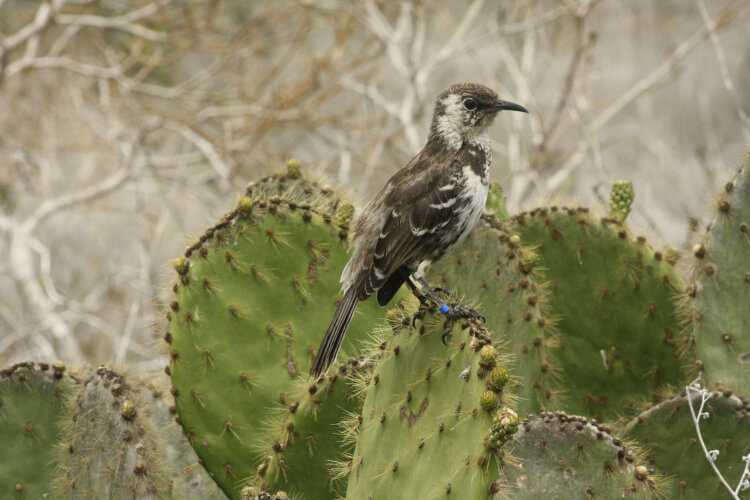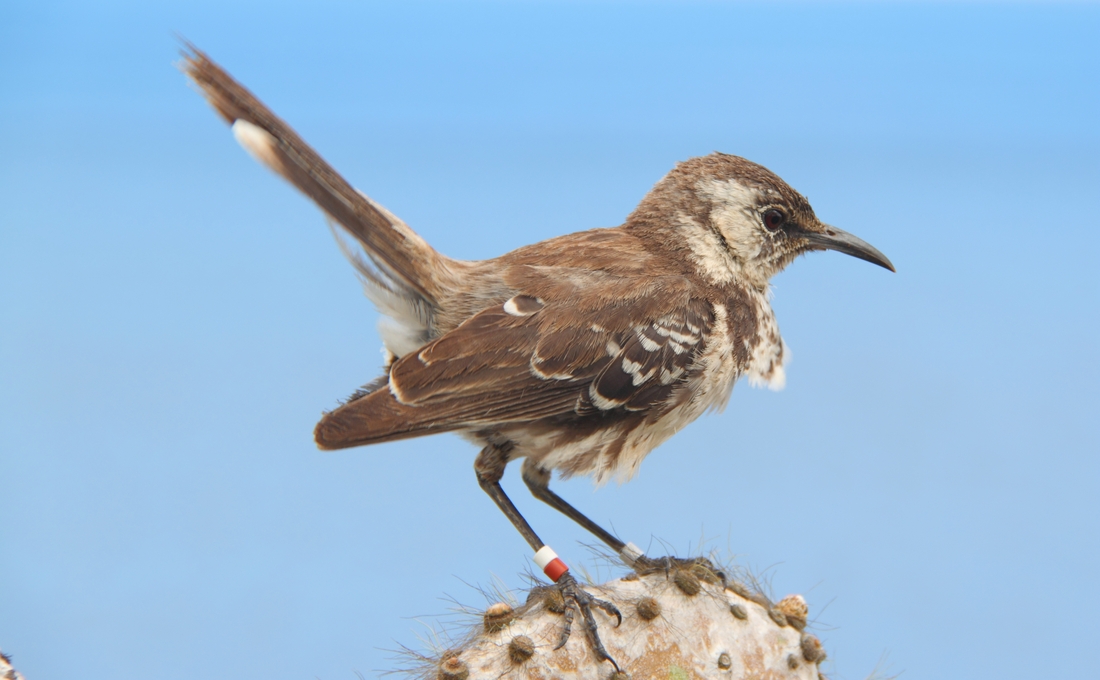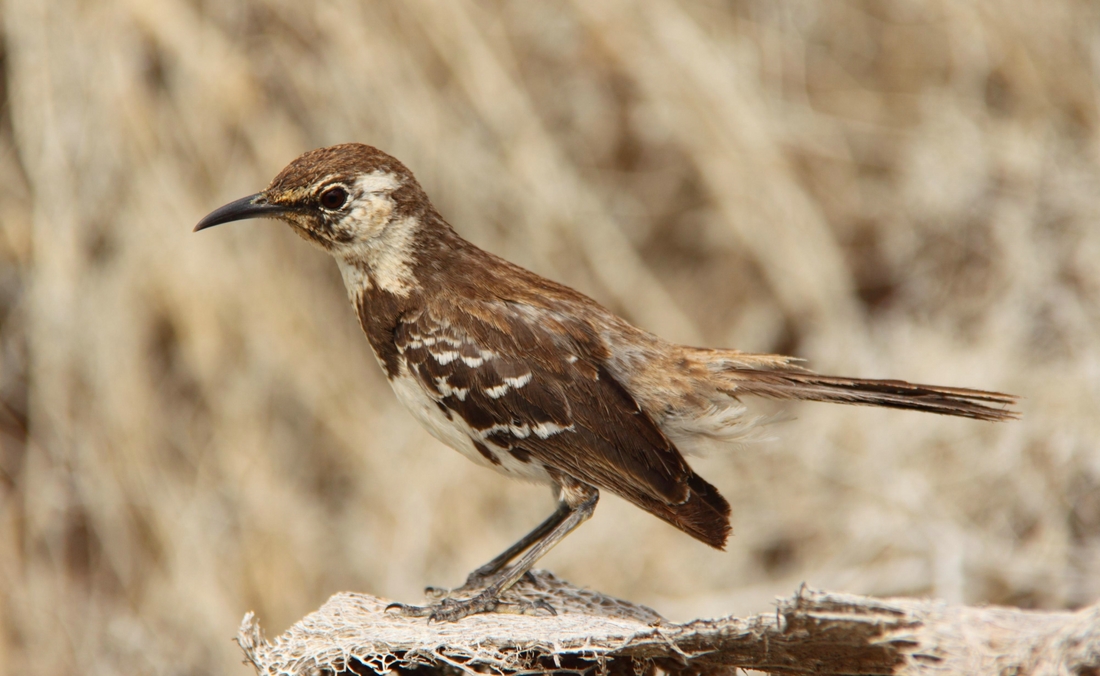Galapagos Species Database
The Galapagos Species Database shares the information about the species from our Natural History Collections.
Mimus trifasciatus
Cucuve de Floreana, Floreana Mockingbird






Threats Rats remain a threat. The birds of Gardner and Champion have not yet been exposed to diseases and may be particularly vulnerable. Pox affects other mockingbirds but has not been found on the islets. Philornis downsi is present in nests on Gardner and Champion but at low levels.
Domain
Eukaryota
Kingdom
Animalia
Phylum
Chordata
Class
Aves
Order
Passeriformes
Family
Mimidae
Genus
Mimus
Species
trifasciatus
Taxon category: Accepted
Syn.: Nesomimus trifasciatus Gould, 1837
Taxon origin: Endemic
Preference for an altitude zone in Galapagos: Coastal zone - transition zone
Habitat preferences: At present, mockingbirds inhabit coastal lowland shrub vegetation dominated by Croton scouleri, Cordia lutea, Jasminocereus thouarsii, Parkinsonia aculeata and Opuntia megasperma. However, this not only reflects species preference but also the habitats available on the islets.
Feeding preferences: Feeding on ground arthropods, such as centipedes, crabs and lizards, but also observed eating a wide variety of fleshy fruits.
Trophic role: Omnivorous
Reproduction mode: Exclusively sexual
Reproductive biology: Breeding occurs mostly around October-May, peaking in February. The clutch is usually composed of 3-4 pale blue eggs. Floreana mockingbirds build several nests before laying eggs and field observations indicate that genetically related and possibly unrelated helpers assist with this task.
Distribution origin: In common with all other Mimus, this species is closely related to species from North America and the Caribbean, rather than species from South America, indicating long distance dispersal.
Distribution: Present on Champion and Gardner by Floreana Islet. Extinct on Floreana Island since 1880s. Current population estimate is around 750 individuals among which 70 are on Champion islet. There is a strong annual variability in population size.
- Wiedenfeld, D.A. (2006) Aves, the Galapagos Islands, Ecuador. Check List 2006 2(2): 1-27.
- Jiménez-Uzcátegui, G. Milstead, B., Márquez, C., Zabala, J., Buitrón, P., Llerena, A., et al. (2007) Galapagos vertebrates: endangered status and conservation actions. Galapagos Report 2006–2007. Charles Darwin Foundation, Puerto Ayora, p. 104–110.
- Granizo, T. Pacheco, C., Rivadeneira, M. B., Guerrero M. & Suárez, L. (eds.) (2002) Libro Rojo de las Aves del Ecuador. SIMBIOE/Conservation International/EcoCiencia/Ministerio del Ambiente/IUCN. Serie Libros Rojos del Ecuador, tomo 2. Quito, Ecuador.
- Harris, M.P. (1973) The Galápagos avifauna. Condor 75(3): 265-278.
- Gifford, E.W. (1913) The birds of the Galápagos Islands, with observations on the birds of Cocos and Clipperton Islands (Columbiformes to Pelicaniformes). Expedition of the California Academy of Science, 1905 -1906. Part VIII. Proceedings of the California Academy of Sciences, ser. 4, 2(1): 1-132.
- Salvin, O. (1876) On the avifauna of the Galápagos Archipelago. Transactions of the Zoological Society of London 9: 447-510.
- Arbogast, B.S. Drovetski, S.V., Curry, R.L., Boag, P.T. & Seutin, G.l (2006) The origin and diversification of Galápagos mockingbirds. Evolution 60: 370-382.
- Grant, P.R. Curry, R.L. & Grant, B.R. (2000) A remnant population of the Floreana Mockingbird on Champion Island, Galápagos. Biological Conservation 92: 285-290.
- Sundevall, C.J. (1871) On birds from the Galápagos Islands. Proceedings of the Zoological Society of London 1871: 124-129.
- Castro, I. Phillips, A. (1996) A Guide to the Birds of the Galapagos Islands. Christopher Helm Publishers Ltd., London.
- Swarth, H.S. (1931) The Avifauna of the Galapagos Islands. Occ. Pap. Calif. Acad. Sci. 18: 1-299.
- Jiménez-Uzcátegui, G. Llerena, W., Milstead, W.B., Lomas, E.E. & Wiedenfeld, D.A. (2011) Is the population of the Floreana mockingbird Mimus trifasciatus declining? Cotinga 33: 1-7.
- Deem, S.L. Parker, P.G., Cruz, M.B., Merkel, J. & Hoeck, P.E.A. (2011) Comparison of blood values and health status of Floreana Mockingbird (Mimus trifasciatus) on the islands of Champion and Gardner-by-Floreana, Galápagos Islands. Journal of Wildlife Diseases 47:94
- Wiedenfeld, D.A. Jiménez-Uzcátegui, G. (2008) Critical problems for bird conservation in the Galapagos Island. Cotinga 29: 22-27.
- Curry, R.L. (1989) Geographic variation in social organization of Galapagos (Ecuador) Mockingbirds: ecological correlates of group territoriality and cooperative breeding. Behavioral Ecology and Sociobiology 25:147-160.
- Hoeck, P. Bollmer, J., Parker, P. & Keller, L. (2010) Differentiation with drift: a spatio-temporal genetic analysis of Galápagos mockingbird populations (Mimus spp.). Philosophical Transactions of the Royal Society of London. Series B, Biological Sciences 365:1127-1138.
- Curry, R.L. Anderson, D. (1987) Interisland variation in blood drinking by Galapagos mockingbirds. The Auk 104:517-521.
- Curry, R.L. (1986) Whatever happened to the Floreana mockingbird? Noticias de Galápagos - Galápagos Research 43:13-15.
- Curry, R.L. Grant, P. (1990) Galapagos mockingbirds: territorial cooperative breeding in a climatically variable environment. In Stacey, P. & Koenig, W. (Eds.) Cooperative breeding in birds: long term studies of ecology and behavior. Cambridge University Press: 291-331.
- Hoeck, P. Beaumont, M., James, K., Grant, R., Grant, P. & Keller, L. (2009) Saving Darwin’s muse: evolutionary genetics for the recovery of the Floreana mockingbird. Biology Letters.
- Steadman, D. (1986) Holocene vertebrate fossils from Isla Floreana Galápagos Ecuador. Smithsonian Contributions to Zoology :I-IV; 1-104.
- IUCN (2015) The IUCN Red List of Threatened Species. Version 2015-4. <www.iucnredlist.org>. Downloaded on 20 November 2015.
- Freile, J.F. Santander, T., Jiménez-Uzcátegui, G., Carrasco, L., Cisneros-Heredia, D., Guevara, E., Sánchez-Nivicela, M., Tinoco, B. (2019) Lista Roja de las aves del Ecuador Quito, Ecuador. 97 pp.
- Integrated Taxonomic Information System (2021) Integrated Taxonomic Information System (ITIS). Www.itis.gov
- GBIF Secretariat (2021) GBIF Backbone Taxonomy. Https://doi.org/10.15468/39omei Accessed via https://www.gbif.org/species/5284517



Feeding type: Polyphagous
Arthropods, lizards and fruits